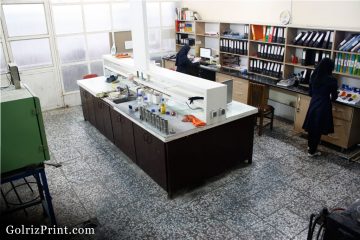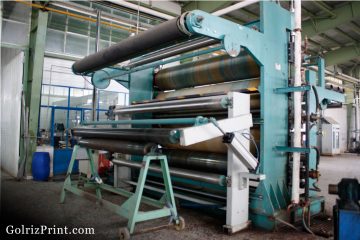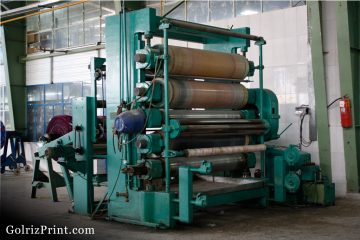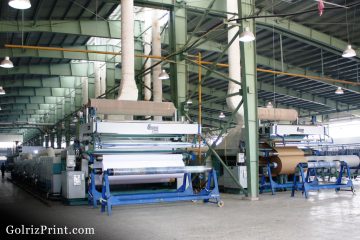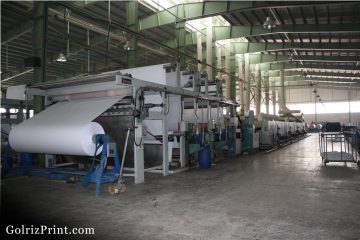
Tel :
+98-31-33808812
+98-31-33808813
+98-31-33808814
+98-31-33808815
Fax :
+98-31-33800545
Email: info@golrizprint.com
GolrizPrint Co
Street 34th, MahmoudAbad Ind. Zone, Esfahan, Iran
FINISHING
Golriz Esfahan Services
Desizing
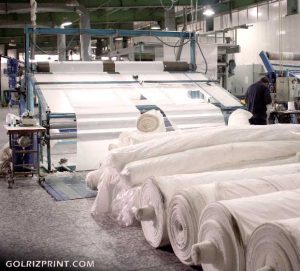 Sizing agents are added to fibers in order to improve their strength and bending behavior during the weaving process. Once the fibers are woven, the sizing agents need to be removed from the fabric in a process called desizing. It is important to remove sizing agents because the starches can react and cause color changes during the scouring process.
Sizing agents are added to fibers in order to improve their strength and bending behavior during the weaving process. Once the fibers are woven, the sizing agents need to be removed from the fabric in a process called desizing. It is important to remove sizing agents because the starches can react and cause color changes during the scouring process.
Desizing, irrespective of what the desizing agent is, involves impregnation of the fabric with the desizing agent, allowing the desizing agent to degrade or solubilise the size material, and finally to wash out the degradation products. The major desizing processes are:
- Enzymatic desizing of starches on cotton fabrics
- Oxidative desizing
- Acid desizing
- Removal of water-soluble sizes
Enzymatic desizing
Enzymatic desizing is the classical desizing process of degrading starch size on cotton fabrics using enzymes. Enzymes are complex organic, soluble bio-catalysts, formed by living organisms, that catalyze chemical reaction in biological processes. Enzymes are quite specific in their action on a particular substance. A small quantity of enzyme is able to decompose a large quantity of the substance it acts upon. Enzymes are usually named by the kind of substance degraded in the reaction it catalyzes.
Amylases are the enzymes that hydrolyses and reduce the molecular weight of amylose and amylopectin molecules in starch, rendering it water-soluble enough to be washed off the fabric.
Effective enzymatic desizing require strict control of pH, temperature, water hardness, electrolyte addition and choice of surfactant.
Oxidative desizing
In oxidative desizing, the risk of damage to the cellulose fiber is very high, and its use for desizing is increasingly rare. Oxidative desizing uses potassium or sodium persulfate or sodium bromite as an oxidizing agent.
Acid desizing
Cold solutions of dilute sulphuric or hydrochloric acids are used to hydrolyze the starch, however, this has the disadvantage of also affecting the cellulose fiber in cotton fabrics.
Removal of water-soluble sizes
Fabrics containing water-soluble sizes can be desized by washing using hot water, perhaps containing wetting agents (surfactants) and a mild alkali. The water replaces the size on the outer surface of the fiber, and absorbs within the fiber to remove any fabric residue.
Water Repelling
 A mechanical process, in which fabrics are heated and pressed in a controlled and defined way, thus compacting the fabric and controlling the shrinkage.
A mechanical process, in which fabrics are heated and pressed in a controlled and defined way, thus compacting the fabric and controlling the shrinkage.
Sanforization is a process of treatment used for cotton fabrics mainly and most textiles made from natural or chemical fibres, patented by Sanford Lockwood Cluett (1874–1968) in 1930.[1] It is a method of stretching, shrinking and fixing the woven cloth in both length and width before cutting and producing, to reduce the shrinkage which would otherwise occur after washing.
The cloth is continually fed into the sanforizing machine and therein moistened with either water or steam. A rotating cylinder presses a rubber sleeve against another, heated, rotating cylinder. Thereby the sleeve briefly gets compressed and laterally expanded, afterwards relaxing to its normal thickness. The cloth to be treated is transported between rubber sleeve and heated cylinder and is forced to follow this brief compression and lateral expansion, and relaxation. It is thus shrunk.
The greater the pressure applied to the rubber sleeve during the sanforization process, the less shrinking will occur once the shirt is in use. The process may be repeated.
The aim of the process is a cloth which does not shrink significantly during production by cutting, ironing, sewing or, especially, by wearing and washing the finished clothes. Cloth and articles made from it may be labelled to have a specific shrink-proof value (if pre-shrunk), e.g., of under 1%.
Calendering
 A mechanical finish, in which fabrics are passed between one or more rollers, producing a variety of surface effects or texture in a fabric. These finishes include moiré, shine, and glazed, friction, chased and water-marked.
A mechanical finish, in which fabrics are passed between one or more rollers, producing a variety of surface effects or texture in a fabric. These finishes include moiré, shine, and glazed, friction, chased and water-marked.
Calendering is a finishing process used on cloth, paper, or plastic film. A calender is employed, usually to smooth, coat, or thin a material.
With textiles, fabric is passed under rollers at high temperatures and pressures. Calendering is used on fabrics such as moire to produce its watered effect and also on cambric and some types of sateens.
In preparation for calendering, the fabric is folded lengthwise with the front side, or face, inside, and stitched together along the edges. The fabric can be folded together at full width, however this is not done as often as it is more difficult. The fabric is then run through rollers that polish the surface and make the fabric smoother and more lustrous. High temperatures and pressure are used as well. Fabrics that go through the calendering process feel thin, glossy and papery.
The wash durability of a calendared finish on thermoplastic fibres like polyester is higher than on cellulosic fibres such as cotton. On blended fabrics such as Polyester/Cotton the durability depends largely on the proportion of synthetic fibre component present as well as the amount and type of finishing additives used and the machinery and process conditions employed.
Peaching
 Peaching is a finishing process we use on the polycotton for our drill tops. After weaving, fabric is stretched while drying. This is when it takes on its stability. While drying the fabric is ‘peached’ by being brushed with abrasive rollers. These very gently break some of the small fibres on the outside of the fabric, or tease fibres out. If you could look at a peached fabric under a microscope it would look a bit hairy. It’s called peaching because it’s supposed to make the fabric feel like the fur on a peach. This process gives a fabric a nice, soft feel and makes it more comfortable to wear.
Peaching is a finishing process we use on the polycotton for our drill tops. After weaving, fabric is stretched while drying. This is when it takes on its stability. While drying the fabric is ‘peached’ by being brushed with abrasive rollers. These very gently break some of the small fibres on the outside of the fabric, or tease fibres out. If you could look at a peached fabric under a microscope it would look a bit hairy. It’s called peaching because it’s supposed to make the fabric feel like the fur on a peach. This process gives a fabric a nice, soft feel and makes it more comfortable to wear.
 A Fabric softener (also called fabric conditioner) is a chemical compound that is typically applied to laundry during the rinse cycle in a washing machine. Fabric softeners are available as solutions and solids, and may also be impregnated in dryer sheets used in a clothes dryer.
A Fabric softener (also called fabric conditioner) is a chemical compound that is typically applied to laundry during the rinse cycle in a washing machine. Fabric softeners are available as solutions and solids, and may also be impregnated in dryer sheets used in a clothes dryer.
Varieties
Many modern washing machines have a dispenser for adding liquid fabric softener to the load of laundry automatically on the final rinse; in launderette machines it may need to be added manually. Some brands of washing powder have fabric conditioning mixed in which is claimed to save money when compared to buying ordinary washing powder and fabric softener separately. Some manufacturers claim their products make ironing easier and/or make clothes dry faster. All liquid fabric softeners are designed to be added to water – either by adding the product directly to the final rinse water or by 2:1 (water:softener) dilution in an automatic dispenser. Even diluted fabric softener will cause spotting when poured directly onto clothes and can ruin them.
Dry fabric softeners are typically supplied in the form of dryer sheets, which are added to clothing in the clothes dryer to soften the fabric and prevent buildup of static electricity in susceptible fabrics. Many alternative uses of dryer sheets have been suggested by users such as dusting, and removing hair from clothes.
Mechanism of action
Fabric softeners coat the surface of a fabric with chemical compounds that are electrically charged, causing threads to "stand up" from the surface and thereby causing the fabric to feel softer. Cationic softeners bind by electrostatic attraction to the negatively charged groups on the surface of the fibers and neutralize their charge; the long aliphatic chains are then oriented towards the outside of the fiber, imparting lubricity.
The electrically conductive fabric softener chemicals may also prevent buildup of static charge that can occur in clothes dryers. Other functions claimed by manufacturers include improvements of iron glide during ironing, increased stain resistance, reduction of wrinkling and pilling, and reduced drying time. Many contain fragrances. Cationic fabric softeners are added during the rinse cycle rather than the wash cycle, as they can interfere with the cleaning action of detergents.[citation needed]
In addition to fabric softening chemicals, fabric softeners may include acids or bases for maintaining the optimal pH for absorption, silicone-based anti-foaming agents, emulsion stabilizers, fragrances, and colors.
Composition
Early cotton softeners were typically based on water emulsion of soap and olive oil, corn oil, or tallow oil.[citation needed] The softening compounds differ in affinity to different materials. Some are better for cellulose-based fibers (i.e., cotton), others have higher affinity to hydrophobic materials like nylon, polyethylene terephthalate, polyacrylonitrile, etc. Silicone-based compounds such as polydimethylsiloxane comprise the new softeners which work by lubricating the fibers. Derivatives with amine- or amide-containing functional groups are used as well. These groups help the softeners bind better to fabrics.
As the softeners themselves are often hydrophobic, they are commonly occurring in the form of an emulsion. In the early formulations, soaps were used as emulsifiers. The emulsions are usually opaque, milky fluids. However there are also microemulsions where the droplets of the hydrophobic phase are substantially smaller[not specific enough to verify]. The advantage of microemulsions is in the increased ability of the smaller particles to penetrate into the fibers. A mixture of cationic and non-ionic surfactants is often used as an emulsifier. Another approach is using a polymeric network, an emulsion polymer.
Cationic fabric softeners
In the 1950s, distearyldimethylammonium chloride (DHTDMAC), was introduced as a fabric softener initially to counteract the harsh feel that the machine washing imparted to nappies. This compound was discontinued because the cation biodegrades very slowly. Contemporary fabric softeners tend to be based on salts of quaternary ammonium cations. Characteristically, the cations contain one or two long alkyl chains derived from fatty acids. Other cationic compounds can be derived from imidazolium, substituted amine salts, or quaternary alkoxy ammonium salts.
Anionic fabric softeners
Anionic softeners and antistatic agents can be, for example, salts of monoesters and diesters of phosphoric acid and the fatty alcohols. These are often used together with the conventional cationic softeners. Cationic softeners are incompatible with anionic surfactants used in detergents because they combine with them to form a solid precipitate. So, they must instead be added during the rinse cycle. Anionic softeners can be combined with anionic surfactants directly. Other anionic softeners can be based on smectite clays. Some compounds, such as ethoxylated phosphate esters, have softening, anti-static, and surfactant properties.
Risks
Together with soaps and detergents, fabric softeners are a common household product that may cause irritant dermatitis. Some fabric softeners are made without dyes and perfumes so as to reduce the possibility of skin irritation. Overuse of fabric softeners may make clothes more flammable, due to the fat-based nature of most softeners; several deaths have been attributed to this phenomenon, and fabric softener makers recommend not using them on clothes labeled as flame-resistant.

 English
English  فارسی
فارسی 